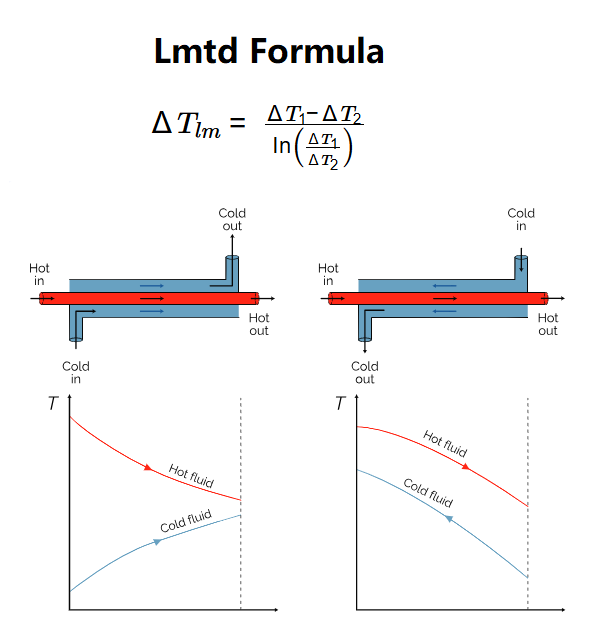1. What is LMTD Calculator?
Definition: This calculator computes the Logarithmic Mean Temperature Difference (LMTD), which is the logarithmic mean of the temperature differences between the hot and cold fluids at the inlet and outlet of a heat exchanger.
Purpose: It is used in heat exchanger design to determine the effective temperature difference driving heat transfer, which is essential for calculating the heat transfer rate and sizing the exchanger.
2. How Does the Calculator Work?
The calculator uses the LMTD formula:
- \( \Delta T_{lm} = \frac{\Delta T_1 - \Delta T_2}{\ln \left( \frac{\Delta T_1}{\Delta T_2} \right)} \)
Where:
- \( \Delta T_1 \): Temperature difference at the inlet (\( T_{h,in} - T_{c,out} \));
- \( \Delta T_2 \): Temperature difference at the outlet (\( T_{h,out} - T_{c,in} \));
- \( \Delta T_{lm} \): Logarithmic mean temperature difference;
- \( T_{h,in}, T_{h,out} \): Hot fluid inlet and outlet temperatures;
- \( T_{c,in}, T_{c,out} \): Cold fluid inlet and outlet temperatures.
Steps:
- Enter the hot fluid inlet temperature (\( T_{h,in} \)) in °C.
- Enter the hot fluid outlet temperature (\( T_{h,out} \)) in °C.
- Enter the cold fluid inlet temperature (\( T_{c,in} \)) in °C.
- Enter the cold fluid outlet temperature (\( T_{c,out} \)) in °C.
- Calculate \( \Delta T_1 \) and \( \Delta T_2 \).
- Compute the LMTD using the formula, handling the special case where \( \Delta T_1 = \Delta T_2 \).
- Display the results in °C, formatted in scientific notation if the absolute value is less than 0.001, otherwise with 4 decimal places.
3. Importance of LMTD Calculation
Calculating LMTD is crucial for:
- Heat Exchanger Design: Determining the effective temperature difference to calculate the heat transfer rate and size the exchanger.
- Energy Efficiency: Optimizing the performance of heat exchangers in HVAC systems, power plants, and industrial processes.
- Process Engineering: Ensuring efficient heat transfer in chemical and manufacturing processes.
4. Using the Calculator
Example 1 (Parallel Flow Heat Exchanger): Calculate the LMTD for a parallel flow heat exchanger:
- Hot Inlet: \( T_{h,in} = 100 \, \text{°C} \);
- Hot Outlet: \( T_{h,out} = 60 \, \text{°C} \);
- Cold Inlet: \( T_{c,in} = 20 \, \text{°C} \);
- Cold Outlet: \( T_{c,out} = 50 \, \text{°C} \);
- \( \Delta T_1 = 100 - 50 = 50 \, \text{°C} \);
- \( \Delta T_2 = 60 - 20 = 40 \, \text{°C} \);
- LMTD: \( \Delta T_{lm} = \frac{50 - 40}{\ln \left( \frac{50}{40} \right)} \approx 44.7214 \, \text{°C} \);
- Result: \( \Delta T_1 = 50.0000 \, \text{°C} \), \( \Delta T_2 = 40.0000 \, \text{°C} \), \( \Delta T_{lm} \approx 44.7214 \, \text{°C} \).
Example 2 (Counter Flow): Calculate the LMTD for a counter flow heat exchanger:
- Hot Inlet: \( T_{h,in} = 100 \, \text{°C} \);
- Hot Outlet: \( T_{h,out} = 60 \, \text{°C} \);
- Cold Inlet: \( T_{c,in} = 20 \, \text{°C} \);
- Cold Outlet: \( T_{c,out} = 50 \, \text{°C} \);
- \( \Delta T_1 = 50 \, \text{°C} \), \( \Delta T_2 = 40 \, \text{°C} \), \( \Delta T_{lm} \approx 44.7214 \, \text{°C} \);
- Result: \( \Delta T_1 = 50.0000 \, \text{°C} \), \( \Delta T_2 = 40.0000 \, \text{°C} \), \( \Delta T_{lm} = 44.7214 \, \text{°C} \).
5. Frequently Asked Questions (FAQ)
Q: What is LMTD?
A: LMTD stands for Logarithmic Mean Temperature Difference, a measure of the effective temperature difference driving heat transfer in a heat exchanger.
Q: Why is LMTD used instead of a simple average?
A: The logarithmic mean accounts for the exponential nature of temperature changes in heat exchangers, providing a more accurate average temperature difference than a simple arithmetic mean.
Q: Does this calculator work for both parallel and counter flow heat exchangers?
A: Yes, the LMTD formula applies to both parallel and counter flow heat exchangers, as long as the temperature differences are calculated correctly based on the flow arrangement.
 Home
Home
 Back
Back
